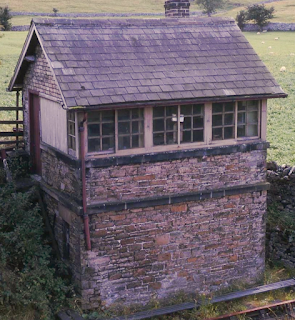Concrete Capers
Or, alternatively:
Cast Concrete is Heavy!
In previous blog posts, we have built and installed benches on site for the point rodding using materials that we recovered from on site. However, we require more benches than we had material to construct, so some new concrete bench legs were ordered, and delivered to site. These will allow us to complete the point control from the box as well as the groundframe.
 |
| Freshly cast legs, as delivered |
So as to avoid making the place look like a builders' yard (as well as making it easier for ourselves when it comes to the installation), we shifted all the new legs to be close to their final locations. They aren't the lightest of lumps!!
 |
| Some of the legs delivered close to their final positions ...But far enough away to allow us to dig the holes required! |
Whilst getting stuck in to moving the new legs, we also collected up a load of the damaged, recovered legs (and concrete tops). Some of the damaged legs can be cut down for re-use on other jobs, whereas others were simply for disposal. Even in their destroyed states, they were still heavy!!
 |
| An assorted load of scrap concrete. |
Now it's a case of handing over to the Moles of Kirkby Stephen to get digging all the legs into place...
Not to be content with pre-cast lumps of concrete, we have been working away to prepare footings for two location cupboards, located near to the motor points. Matt has been welding up the rebar and studding onto which these will mount, when set in a lump of concrete.
 |
| The beginnings of the studding / rebar on the bottom of the location cupboard. |
 |
| Now the plywood template can be seen. |
Formers were made from plywood,to keep the studs in their correct position, so as to match the holes in the location cupboards themselves. These were then welded to lengths of rebar and mesh so that they were self-supporting, albeit with the plywood template retained on top, just to be on the safe side!
 |
| In position, carefully levelled and aligned, with more filling in to be completed around the exterior of the shuttering. The main shed roof drain pipe can be seen here! |
 |
| More of the same: this timd the two vertical (ish) pipes can be seen, allowing any water that gets in, to get out... |
A hole was excavated by the Moles for the construction to sit in, and shuttering was built around it, with earth and stones packed around that to hold it in place. A little modification to the rebar was required, to ensure if fitted around the shed drain, meaning we didn't have to raise everything up too high.
 |
| Mixing our own concrete... |
 |
| ...and spooning it into place, tamping it down and getting air bubbles out. |
It was then time to fire up the mixed, and produce enough concrete to fill in the shuttering. Two offcuts of pipe were also set in at this stage, to enable any water to drain away, through the slab.
 |
| Cured, awaiting a cupboard after removing the shuttering. |
The last little bit of concrete was used to set the second rebar construction in place in its hole, keeping it nice and level as it awaits another mix!
Thanks for reading - more soon!




Comments
Post a Comment